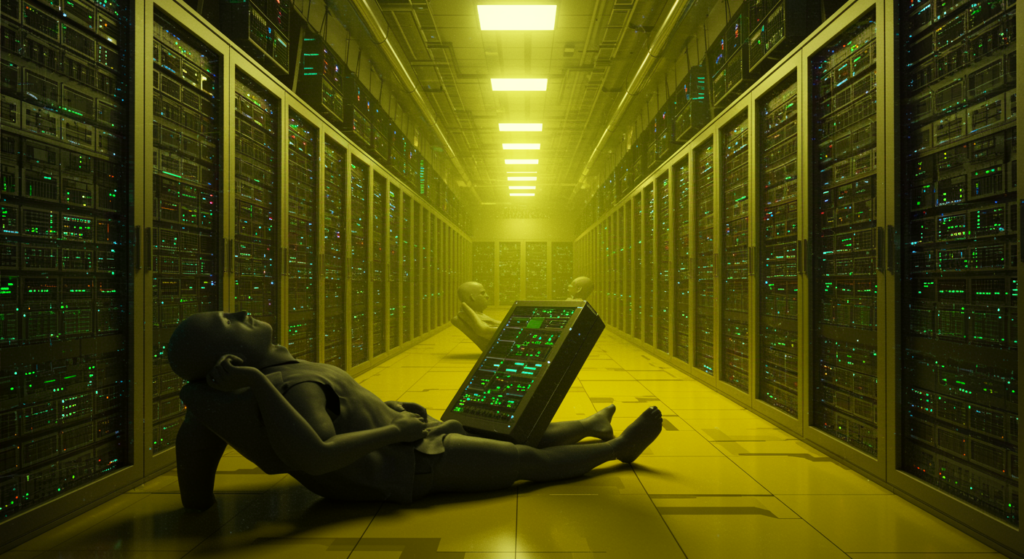
AI Data Centers Slow as Amazon and Microsoft Pause
In the rapidly evolving landscape of AI data centers, major tech players are rethinking their strategies. Economic pressures and potential oversupply are prompting companies like Amazon and Microsoft to scale back, even as the demand for advanced AI capabilities continues to grow. This shift raises important questions about the future of AI infrastructure and what it means for innovation.
Economic Uncertainty Impacting AI Data Centers
The surge in AI data centers has been fueled by breakthroughs in technologies like generative AI, but global economic challenges are now putting the brakes on expansion. Factors such as rising tariffs and construction costs are making it tougher for companies to justify new investments, leading to a noticeable slowdown in projects worldwide.
Have you ever wondered how economic fluctuations can ripple through tech sectors? For instance, tariffs on essential components have driven up expenses, forcing firms to pause or cancel plans. A report from PYMNTS highlights how these costs are directly affecting AI data centers, with Microsoft halting a $1 billion project in Ohio as a prime example.
Rising Costs and Tariffs in AI Data Centers
Building and maintaining AI data centers isn’t cheap, and recent tariff hikes have amplified the financial strain. Microsoft and Amazon are among those feeling the pinch, with Amazon slowing its leasing activities to avoid overcommitment. According to PYMNTS, this caution stems from broader market instability, where every dollar counts in an uncertain economy.
Imagine planning a massive data center only to see costs skyrocket—it’s a scenario that’s becoming all too real. By focusing on efficiency, companies could mitigate these issues, such as opting for modular designs that adapt to fluctuating demands. This approach not only cuts expenses but also ensures AI data centers remain viable long-term investments.
The Overexpansion Lesson from China’s AI Data Centers
China’s rapid push into AI data centers offers a stark warning about unchecked growth. Between 2023 and 2024, over 500 projects were launched, but many fell short due to poor planning and market shifts, resulting in idle facilities and losses.
This boom-and-bust cycle in AI data centers underscores the risks of prioritizing speed over sustainability. As more affordable AI solutions like DeepSeek emerge, the need for extensive infrastructure diminishes, leaving operators with underutilized assets.
Key Challenges in China’s AI Data Centers Boom
Rapid overexpansion led to a flood of AI data centers that didn’t align with actual demand, creating a glut of subpar facilities. Many projects ignored technical standards, leading to inefficiencies and financial woes for the companies involved.
What can we learn from this? It’s a reminder that thorough market analysis is crucial before diving in. For example, if you’re in the tech industry, consider conducting feasibility studies to avoid similar pitfalls in your own AI data centers endeavors.
Market dynamics, like the rise of cost-effective AI tools, have further complicated things, reducing the ROI for these centers. This situation highlights the importance of adaptability—perhaps by retrofitting existing AI data centers with newer tech to stay competitive.
Strategic Changes in AI Data Centers by Tech Giants
Amid these challenges, Microsoft and Amazon are making pivotal adjustments to their AI data centers strategies. Oversupply concerns have prompted Microsoft to cancel several leases, while Amazon is proceeding more cautiously, reflecting a broader industry rethink.
These moves aren’t just about cutting costs; they’re about positioning for future growth. If demand rebounds, as experts predict, these companies could pivot quickly, turning potential setbacks into opportunities.
Microsoft’s Shifts in AI Data Centers Approach
Microsoft has canceled multiple data center leases, signaling a strategic pullback from aggressive expansion. This decision points to a focus on reallocating resources, particularly back to U.S.-based AI data centers, where regulatory environments might be more favorable.
By doing so, Microsoft is emphasizing quality over quantity, which could set a new standard for the industry. Think about it: in a world where AI data centers are essential for processing vast amounts of information, streamlining operations can lead to better performance and innovation.
Amazon’s Stance on AI Data Centers
Despite the slowdown, Amazon and partners like Nvidia insist that the underlying demand for AI data centers remains strong. They’re not halting entirely but are instead prioritizing high-impact projects that align with current market needs.
This balanced approach could be a smart move—after all, who wants to overbuild in a volatile economy? Amazon’s strategy might inspire others to adopt more flexible models, ensuring their AI data centers evolve with technological advancements.
Future Prospects for AI Data Centers
Looking ahead, the outlook for AI data centers is optimistic despite short-term hurdles. Projections from Goldman Sachs suggest a 165% jump in power demand by 2030, driven by AI’s expansion, which could revitalize the sector.
While economic uncertainty lingers, the core drivers of AI data centers—such as enhanced computing needs—aren’t going away. This resilience points to a future where efficiency and innovation take center stage.
Growth Opportunities in AI Data Centers
As AI technologies advance, the demand for robust AI data centers will only increase, opening doors for new developments. Improvements in energy efficiency and scalable designs could lower operational costs, making these centers more accessible.
For businesses, this means exploring partnerships or upgrades to existing infrastructure. A hypothetical scenario: if your company invests in green AI data centers now, you could not only reduce your carbon footprint but also gain a competitive edge in sustainability-focused markets.
Technological innovations, like advanced cooling systems, promise to make AI data centers more sustainable and cost-effective. By staying ahead of the curve, companies can turn challenges into chances for growth, ensuring they’re prepared for the next wave of AI breakthroughs.
In wrapping up, while pauses from Amazon and Microsoft highlight immediate pressures on AI data centers, the long-term potential is undeniable. As the industry adapts, we might see smarter, more efficient expansions that balance risk and reward. What are your thoughts on how these changes could shape the future of AI? Share your insights in the comments, or explore more on our site about emerging tech trends.
Sources
- PYMNTS. “AWS, Microsoft Slow Down Data Center Deployments.” https://www.pymnts.com/technology/2025/aws-microsoft-slow-down-data-center-deployments/
- Marketplace. “AI Data Center Investment Slows Amid Economic Uncertainty.” https://www.marketplace.org/story/2025/04/22/ai-data-center-investment-slows-amid-economic-uncertainty
- Tom’s Hardware. “China’s AI Data Center Boom Goes Bust.” https://www.tomshardware.com/tech-industry/artificial-intelligence/chinas-ai-data-center-boom-goes-bust-rush-leaves-billions-of-dollars-in-idle-infrastructure
- TheStreet. “Fewer Americans Traveling; AI Data Centers in Demand.” https://pro.thestreet.com/portfolio/fewer-americans-traveling-ai-data-centers-in-demand-cybercrimes-and-more-news-to-trade
- Capacity Media. “Microsoft Cancels AI Data Centre Leases Amid Oversupply Concerns.” https://www.capacitymedia.com/article/2eglo1sjjq2613vy3lz40/news/microsoft-cancels-ai-data-centre-leases-amid-oversupply-concerns-report
- Channel Futures. “AWS, Azure Data Center Pause: Cloud Marketplace Shifts.” https://www.channelfutures.com/cloud/aws-azure-data-center-pause-cloud-marketplace-shifts
- Search Engine Land. “What Is SEO?” https://searchengineland.com/guide/what-is-seo
- Goldman Sachs. “AI to Drive 165% Increase in Data Center Power Demand by 2030.” https://www.goldmansachs.com/insights/articles/ai-to-drive-165-increase-in-data-center-power-demand-by-2030
AI data centers, Amazon, Microsoft, data center developments, economic uncertainty, AI infrastructure, generative AI, data center oversupply, tech investments, AI growth







